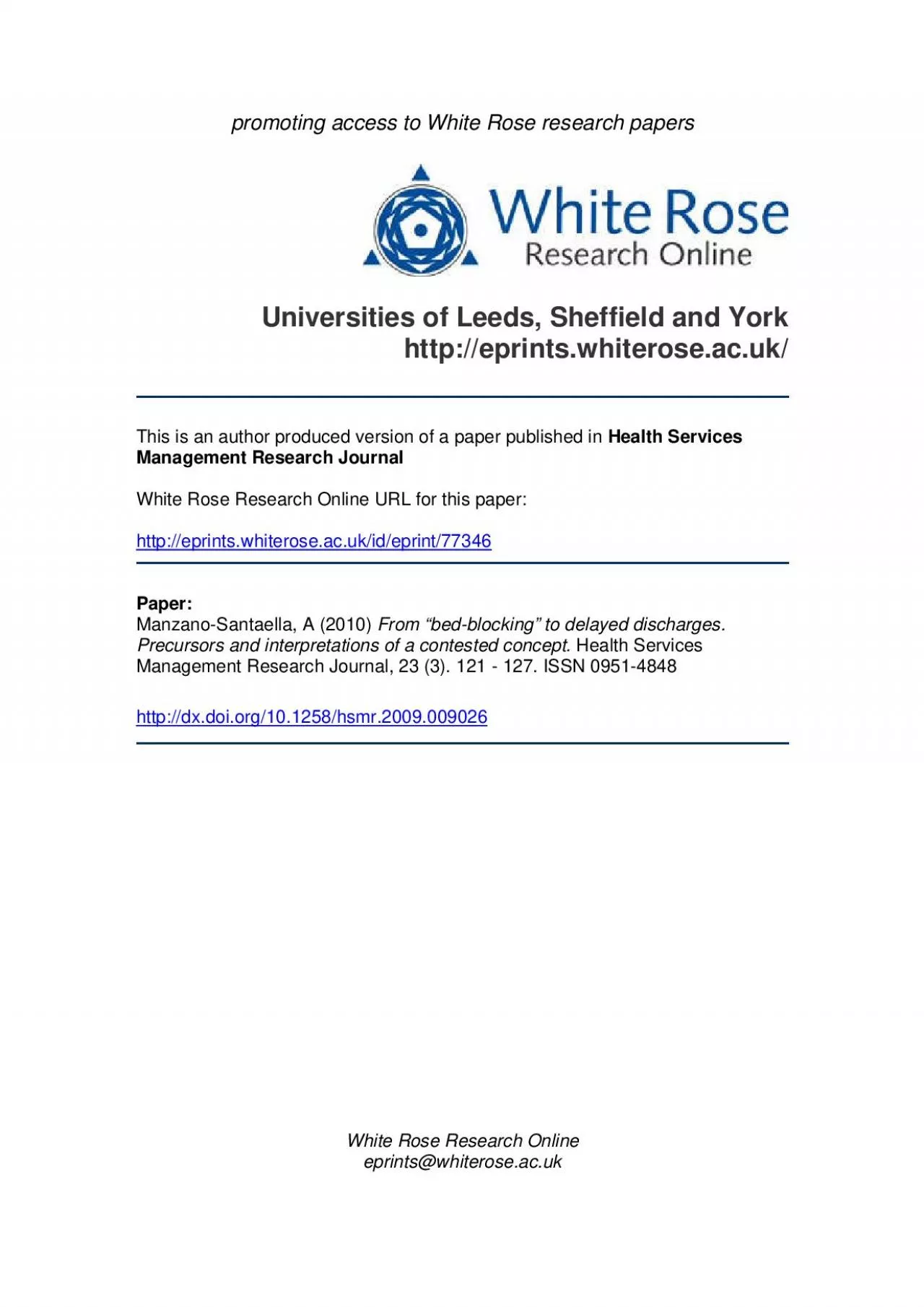

WhiteRoseResearchOnline eprintswhiteroseacuk UniversitiesofLeedsSheffieldandYork httpeprintswhiteroseacuk Thisisanauthorproducedversionofapaperpublishedin HealthServices ManagementResearchJ ID: 937470
Download Pdf The PPT/PDF document "promotingaccesstoWhiteRoseresearchpapers" is the property of its rightful owner. Permission is granted to download and print the materials on this web site for personal, non-commercial use only, and to display it on your personal computer provided you do not modify the materials and that you retain all copyright notices contained in the materials. By downloading content from our website, you accept the terms of this agreement.
promotingaccesstoWhiteRoseresearchpapers WhiteRoseResearchOnline eprints@whiterose.ac.uk UniversitiesofLeeds,SheffieldandYork http://eprints.whiterose.ac.uk/ Thisisanauthorproducedversionofapaperpublishedin HealthServices ManagementResearchJournal WhiteRoseResearchOnlineURLforthispaper: http://eprints.whiterose.ac.uk/id/eprint/77346 Paper: Manzano-Santaella,A(2010) From“bed-blocking”todelayeddischarges. Precursorsandinterpretationsofacontestedconcept. HealthServices ManagementResearchJournal,23(3).121-127.ISSN0951-4848 http://dx.doi.org/10.1258/hsmr.2009.009026 1 Title FromBed-BlockingtoDelayedDischarges:PrecursorsandInterpretationsofaContested Concept Abstract DelayedhospitaldischargeshavebeenidentifiedasaproblemfortheEnglishNational HealthServiceandhavepromptedseveralpolicyandservicedevelopmentresponsesin thelastdecade.However,bed-blockingisanissuesurroundedbyrivalinterpretationson howandwhyhospitaldelaysoccurandthewayinwhichtheyaremeasured.Tobetter understandthiscontestedconcept,thisarticleprovidesabriefdescriptionofthehistorical accountsthatframedtheemergenceofdelayedhospitaldischargesasaphenomenon. Threekeyfeaturesofthebed-blockingconceptarealsoanalysed:thereductionof patients’lengthofstaytoimproveefficiency;theintrinsicmethodologicaldifficultiesof measuringhospitaldelays;andthemostc
ommonreasonsfordelayeddischarges.A descriptionofthecharacteristicsofthepatientsfrequentlylabelledasdelayeddischarge, theircommontraitsandhowthesehavebeenexaminedbypreviousresearchisalso provided.Finally,thisarticlearguesthatthepresenceofhospitaldelaysinahealth systemtendstobeconsideredasanindicatoroftwopossiblesysteminefficiencies:a failureinthedischargeplanningprocess,whichgenerallyblamessocialservices departmentsfornotensuringtimelyservices;orashortageofalternativeformsofcare forthisgroupofpatients. 2 Introduction Overthelastthirtyyears,mostwesternnations,influencedbyneoliberalideologies, embarkedonhealthcarereformsthatareoftencharacterisedas‘decentralisation’and ‘devolution’.Theshiftofresponsibilityawayfromthestatethroughtheintroductionof marketforcesextendedtoallaspectsofgovernance.Throughoutthedevelopmentof Britishwelfarepolicy,thestatewasresponsibleforfinance,ownershipandsupplyof healthcareandsocialcare.Foundedin1948,theNationalHealthService(NHS)wasseen asatriumphofsocialistideology,inspiredbyegalitarianideasasitinstitutionalisedthe principleofallocatingresourcesaccordingtoneed.However,asinmanyotherareasof welfare,astimewentby,theNHSattractedcriticismstypicaltosuchlargepublic organisations:inefficiency,slowtochangeandawasteoftax-payersmoney. Consequently,undertheConservativeGov
ernmentofthelate1980’sandearly1990’s, de-institutionalisation,privatisationofcarehomesanddecentralisationwerekey strategiesunderlyinghealthreformswhichculminatedintheintroductionoftheNHSand CommunityCareAct1990. Thepurchaser-providersystemnowoperatingintheNHSwasacentralpartofthis legislation.Stateprovisionforhealthandsocialcarewastargetedforreplacementwitha quasi-marketorientedapproachtowelfareservicedelivery.Suchasystemisbasedon centralgovernmentraisingthefundsforpurchasingservices,whicharethendistributed toagentswhopurchasetheseservicesonbehalfofconsumers.Theconstructionof internalmarketswasbasedonthebeliefthathealthcareinthepurchaser-providersystem wouldgenerateincreasedcostawarenessandhenceencouragemoreefficientuseof 3 resources.Financialefficiencywastobeachievednotwithincreasedfundsbutthrough betterperformancemanagement,delegatingresponsibilityforthedeliveryofhealthcare tolocallevel. Beforethe1990reforms,thestatewasaproviderofsocialcareformuchofits population:funding,purchasingandprovidingcareservices.Afterthereorganisation, localauthoritiestookonthecharacteristicsofpurchasers.Theemergenceofa management-orientedapproachtocommunitycareplanningmeantthatthestatewas supposedtoenablesocialcare,settingtheemphasisonmanagingpackagesofcarefor peopleinthecommunityratherthanmatchingpeoples’need
stoservices.Voluntaryand privateorganisations(andfamilies)undertooktheprovisionofsocialcareonbehalfof thecouncil,andsocialworkersweregiventheroleof‘caremanagers’. Therelocationofcarefrominstitutionstothecommunitymeantatransferofthecostof carefromthestatetoothersocialcareactors:users,theircarersandfamilies,voluntary sectororganisationsandfor-profitorganisations.Theearlydischargeofpeoplefrom hospitalorcareinstitutionalsoincreasedthefinancialburdenuponsocialservices departmentsandprimaryhealthcareservices.Furthermore,theconstantdevelopmentof initiativesthatreducedhospital-basedNHScarerepresentedtherelocationoffreecareat thepointofdeliverytocommunityservices,whicharemeans-testedandincurcharges forthepopulation.Inotherwords,theredefinitionofsomeacuteandcontinuingcareas ‘socialcare’hadaneconomicconsequencefortheendusersofservicesthatshouldnot beignored. 4 The1990NHSandCommunityCareActcontinuedthehistoricaldivisionbetweenhealth andsocialcare.EligibilitycriteriaforfreeNHScontinuingcareandtheappropriateness ofdischargingvulnerablepatientsfromhospitalbecamemajorpoliticalissuesduringthe 1990s.Withinthisframework,in1997,NewLabourproposed‘TheNewNHS’,aten yearplanfortheNHS.Whilepreservingmanyfeaturesoftheinternalmarket,thiswas intendedtoshiftthefocusofservicesfromcompetitiontocooperation
.Government emphasisturnedto‘integratedcare’and‘partnerships’. 1 Inthiscontext,theolddivisions betweenhealthandsocialcarewereidentifiedascreatingparticularobstaclestothe planninganddeliveryof‘seamless’servicestailoredtoindividualneeds. 2 In2003,anotherinitiativethatattemptedtoreducehospitalbasedcarewasintroduced: theCommunityCare(DelayedDischargesetc.)Act2003. 3 Thispolicymeantthatlocal authoritiesweremadefinanciallyresponsiblefortheaccommodationcosts(hotel services)thatpatientswithsocialneedsreceivewhilstinacutecare.Thisfigurewas calculatedinadailytariffequalforallpatients(£100perday),withtheexceptionof localitiesintheSouthEastofEngland(£120perday).Asaconsequence, administratively,socialservicesdepartmentsweretreatedaspurchasersofaservice (acutecare)for‘theirclients’,providedbythehospitals. Inthispolicy,thepartnershipethoscollidedwiththeneedforefficiency,whichwas constructedunderaconceptemblematicofthatdivision:theproblemofbed-blockingor delayeddischarges.Thephenomenonisdeep-seatedwithintheproblematic 5 administrative,financialandprofessionaldivisionofhealthandsocialcare.Inorderto investigatetherivalinterpretationsaffectingthetopicofbed-blocking,threekeyfeatures oftheconceptaredescribed:thereductionofpatients’lengthofstayasamanagement tooltoimproveefficien
cy;theintrinsicmethodologicaldifficultiesofmeasuringhospital delays;andthemostcommonreasonsfordelayedhospitaldischarges.Finally,thearticle closeswithadescriptionofthecharacteristicsofthepatientsfrequentlylabelledas delayeddischarge,theircommontraitsandhowthesehavebeenexaminedbyprevious research. ‘Bed-Blocking’or‘DelayedDischarge’?AContestedConcept Cultural,social,economicandorganisationalcontextsinfluencehowthepatientgroupof theso-called‘bed-blockers’couldbedefined.Nevertheless,therearerivalconceptions andinterpretationsofthistermwhichcouldthusbeconsideredtocomeundertherubric ofan‘essentiallycontestedconcept’. 4 Bed-blockingisaninternallycomplexterm,open- endedandbasedonqualitativenotions.Interpretationsoftheconceptaredisputedwith particularlinesofthoughtbeingsustainedbydifferentstandpoints.Inbrief,thepresence ofdelaysinahealthsystemmaybeconsideredasanindicatoroftwopossiblesystem inefficiencies:afailureinthedischargeplanningprocess,whichgenerallyblamessocial servicesfornotensuringtimelyservices;orashortageofalternativeformsofcarefor thisgroupofpatients. 6 Theterm'blockedbed'originatedintheUnitedKingdominthelate1950’sanditwas traditionallyusedtoimply‘thatregularpatientorclientthrough-putwithregardtothat particularbedhasstopped’. 5 Synonymousexpressio
nslike‘back-up’,‘backlogs’,‘long- stays’,‘outliers’and‘delayeddischarges’wereusedintheUnitedStatesandCanadaand havesimilarmeaningsdespitethecontextualdifferences.Theyallrefertothefactthat averagebeduseisinterruptedbypatientswhostayinhospitalforlongerthanexpected. Whateverthewordsusedtodescribethisgroupofpatients,similartermswereandstill areappliednotonlytoacutehospitalbedsbutalsotobedsinpsychiatric,geriatricand otherhealthandsocialcareinstitutions. Thebeginningofthebed-blockingphenomenoncannotbeseparatedfromthechanging roleofhospitalsinrespectofgeriatricpatients.Originally,‘bed-blocking’concernswere drivenbyhospitalcliniciansbecomingincreasinglyperturbedwiththeirlimited availabilityofbeds.IntheUKbetween1961and1967,therewasa14percentriseinthe elderlypopulationbutthenumberofhospitalbedsassignedfortheiruseremained practicallythesame. 6 Apparently,therewasstrongcompetitionoverhospitalspace whichledtoadesireonthepartofsomehospitaldoctorstoexcludecareoftheelderly frommajorhospitals.Hall&Bytheway 7 suggestedthathospitaldoctorsfollowedthe prevailing'acuteideology'inmedicineandusedphenomenalikebed-blockingtorestrict olderpeople’sentrytohospital. Therefore,notsurprisingly,earlyinvestigationsintothe‘bed-blocking’phenomenon reliedontheopinio
nofconsultantsforthereasonswhypatientsstayedinhospitallonger 7 thannecessary. 89 Doctors’researchtendedtofocusonthefailureofsocialcareto developtheservicesneededtofacilitatedischarges.Forthisreason,someauthors 10 argue thattheconceptof‘bed-blocking’isanotherexampleofthemedicaldominancethat intrudesintopoliciesandthedailyadministrationofhealthinstitutions. Inthe1990’s,withthedriveforefficiencythatdictatedhealthcareinstitutions,theterm ‘bed-blocking’wasborrowedbyhealtheconomistswhouseditasanexampleofthe failureofefficientsystemsinhospitals.Indeed,inthedebateover'bed-blocking', economiststendedtosidewithhospitaldoctorsandblameinadequatelocalauthority provision.Insummary,reducingtheboundariesofacutecarehadthepotentialtosuit bothcostconsciouspolicymakersandtheprofessionalinclinationsofmanyhospital doctors. In1994,Styrborn 11 arguedthat‘bed-blocking’,despiteitscommonuse,wasnottobe acceptedasamedicaltermbutasanadministrativeconceptthatwaspartofaneconomic controlsystem‘coinedbyhealtheconomists’.Heexplainedthatthetermimpliedthatthe patientwassituatedinthewronglocationinthespectrumofcare.Lateron,followinga similarapproach,Wimo, etal . 12 referredtothe‘misplacement’ofpeoplewhoare situatedatthe‘wrongcaringlevel’andthisnotionincludedtheneedfordive
rsecare alternatives.StyrbornandWimo etal .’sapproachfocusesondefiningthebed-blocking problemastheneedforadifferentplaceorsitewherepatientscouldbelocated.Reasons forrelocatingpatientsrangefromadministrativedecisionsandpoliticalpoliciesto changesinpatients’healthstatus.Mostimportantly,thistypeofconceptualexplanation 8 leadstosolutionstotheproblemthatarebasedonincreasingtheavailabilityof ‘locations’,sites,orspacesforthesepatients. Intherecentyears,theuseoftheadjective‘bed-blocker’torefertopatientshasbeen consideredinappropriateintheUK.Itwasarguedthatthisterminsinuatedthatpatients themselveswereresponsiblefortheirsituation:‘Thewholenotionofbedblockingseems toimplythatolderpeopleenterhospitalandthenwilfullycontinuetooccupyabed which,intheviewsofstaff,theynolongerrequire’ 13 .Thetermwasconsidered politicallyincorrect,deemedoffensiveforpatientsandrejectedbytheHealthSelect Committee.Instead,theexpressions‘delayedtransferofcare’or‘delayeddischarge’ wereproposedtoreplaceit.InApril2001,theDepartmentofHealthissuedastandard definitionandintroducedthesenewterms: Adelayedtransferoccurswhenapatientisreadyfortransferfromageneraland acutehospitalbedbutisstilloccupyingthatbed.Apatientisreadyfortransferwhen: aclinicaldecisionismadethatthepatientisreadyfortransfer
;amulti-disciplinary teamdecisionhasbeenmadethatthepatientisreadyfortransfer;andthepatientis safetodischarge/transfer. 14 Sincethen,theexpression‘delayeddischarges’hasbeenwidelyadoptedintheBritish governmentalandresearchliterature.Althoughithasbeenconsidereda‘moreneutral term’ 15 ,thenewlycoinedexpressionsupportsacleartheoreticalposition.Itimpliesa shiftfromfocusingonmacroeconomicfactorstomicroorganisationalsystems.The exclusivefocusonthetimecomponentofthedischargeprocessshiftedthedebatefrom 9 theavailabilityandsuitabilityofthenextlocation(space),totheinstitutionalprocessof discharge(time).Bedsarenotblockedbutpatients’dischargesaredelayed,which impliesthatsomebody(generally,socialservicesdepartments)shouldworkatafaster pacetoavoidthosedelays. Inaddition,whenredefiningtheneedforrelocationofpatientsintotheneedforspeeding upthedischargeprocess,attentionisdivertednotonlyfromtheavailabilityofother formsofcarebutalsofromothersignificantaspectsofthetransitionsbetweenhospital anddischargedestinations.Someoftheseissuesarethelong-termoutcomes(forthestate andforthepatient)asaconsequenceofrapiddischarges;thequalityandadequacyofthe newenvironmenttowhichpatientsaretransferred;theinvolvementoftheindividuals andtheirfamiliesinthedischargeprocess.Althoughthereareindicationsofthecost- effectivene
ssthatdischargeplanningprogrammesofferwhentheyresultindecreased lengthsofstayandreadmissionrates 16 ,thesecalculationsdonotconsidertheexpenseof additionalcommunityservicesandspecialiststafforthecosttofamiliesandcarers. Indeed,thespeedydischargeofpatientsisnotconsideredbyallcommentatorsasthebest caremodel.Delayedtransfersofcareareparticularlyassociatedwitholderpatientswith complexneedsandgeriatricmedicineoftenpurposelydeceleratestheprocessof dischargetoachievebetterlong-termresults . 17 Theseauthorsexplainthatreducedstays cannotbeusedasmeasureforefficiencyinallpatients.Gainsmadeintheefficiencyof treatingtheacutecarepatientsfasterdonotnecessarilyimplyimprovementsintheir long-termoutcomes.Thesegainsmayevenbemadeattheexpenseofpushingalarger 10 fractionofthepatientsintopermanentcare.Insummary,thereductionoflengthofstay toimprovehospitalefficiencyisamanagementchoicethatisnotalwayssupportedby clinicalevidenceinallpatients. ReducingLengthofStaytoImproveHospitalEfficiency Thephenomenonof‘delayeddischarges’maythusbeunderstoodinthetermsof organisationalmanagementchoice.Healthcareplanners,confrontedwithanincreased numberofpotentialusers,choosetoensurearapidpatientflowasanewtooltoimprove efficiency.Millard&McLean 17 usedtheanalogyofatoytraintoexplainhowanacute hospitalworks.Thehospitalwascomparedwitha24hou
rtraincirclingatrackat constantspeed.Toimprovethepassengercarryingperformanceseveralchoiceswere given: a) Toaddmorecarriages(i.e.morebeds) b) Tostoppassengersgettingonboard(programmestoreduceadmissionsintheover 75’s) c) Tostoppassengersstayingovernight(increasedayserviceslikedaysurgeryand othertreatments) d) Topersuadethepassengerstogetoffthetrainearlierandcontinuetheirjourney elsewhere(earlydischarge,intermediatecareandtransfertosocialcarehomes). AlthoughintheUK,thenumberofhospitaladmissionskeepsgrowing,thepossibilityof increasingthenumberofbedsseemsalwaysomittedfromtheequation.Moreover,the 11 numberofacutebedsinEnglandhasbeenconsistentlyreducedandsolutionsalongthe linesofb)c)andd)aretheonesfrequentlyusedbytheprogrammesimplemented subsequenttotheNHSplan. 18 Otherpossiblesolutionsoutsidethelogicthatthecircular trackrepresentsarealsorejected.Theperformancetargetissimplifiedtothefactthat patientscanonlyenterhospitalifotherpatientsleaveandtherefore,oncepatientsarein, theyshouldbeprocessedoutofthesystemasfastaspossible.Thereduction ad absurdum ofthislinearthinkingisthatnobedswilleventuallybeneededtotreat patients. 19 Whenreductionoflengthofstayschemesareinplace,twodifferentcategoriesof patientsaregenerated:patientswhoneedtoenterorstayinhospitalandpatientswho needtoexit.Thefirstarewelcome,thelatterareno
twelcomeinhospitalanymore. Peoplechangestatusastimegoesby.Thetransformationfromwelcometounwelcome patients,however,isnotstraightforward.Thereareimportantdebatableconcepts attachedtothisissue,suchaswhodecidesthatpatientsshouldexitthehospital,howthis decisionismadeand,insummary,whenarepatients’exitsappropriate. 20 Those unwelcomepatientsaretheso-called‘delayeddischarges’,aby-productofadopting economictheoriesthatrecommenddecreasinglengthofstaytoimprovehospital efficiency. TheUKGovernmentmadethechoiceofselectingreductioninlengthofstayasatoolfor efficiency,statingthatitwasoneofitssixdimensionsofperformance 1 .Despitethe officialchoicetouselengthofstayasameasureforefficiency,thecausalrelationship 12 betweenlengthofstayandqualityofcareisnotstraightforward.Traditionally,muchof theliteratureinthisareaexplainsthathealthoutcomesarenotaffectedbyshorterstays andthatextendedstaysarelinkedtoincreasemorbidity.However,authorslikeClarke& Rosen 21 exposethelackofevidenceoftheassociationbetweenlongerlengthofstayand poorerhealthoutcomes.Theyexplainhowtensionsbetweenreducingstaysinorderto increasepatients’throughputandmaintainingtheappropriatenessofcarearerarely appreciatedbythosekeentoseestaysreducedasamarkerofefficiency. Inaddition,reductioninthelengthofpatients’stayhasalsothepotentialtoincreaseth
e complexityofthedischargeprocess. 22 Healthcareworkisfrequentlyhighlyproblematic duetotheunexpectedandoftendifficulttocontrolcontingencies,stemmingnotonly fromtheillnessitself,butalsofromahostofworkandorganisationalsourcesaswellas frombiographicalandlife-stylesourcespertainingtopatients,relativesandstaff members. 23 Theshorteningofhospitalstayscouldaddtothatcomplexitywiththe potentialofmorecontingenciesoccurringduetothelackoftimehealthcareworkershave tofamiliarisethemselveswiththepatients’circumstances. TheMeasurementofDelayedDischarges:TensionsandChallenges Themethodologicalliteraturestudyingdelayeddischargesraisesseriousquestions relatedtocoreconceptualissuesaboutwhatconstitutesahospital‘delay’.Thislackof consensusisillustratedbyfourmaintensionsinthedefinitionof‘delays’: 13 a) Thefirstapproachdefines‘delay’asthetimeperiodestablishedbyahospital dischargeplannerwhichismeasuredbythetimedifferencebetweenapatientbeing medicallyreadyfordischargeandtheactualtimeofdischarge. 24 Consequently,the resultingfigureisaperiodoftimedefinedsubjectivelybyresearchers,medical practitioners,healthandsocialcarestaffor,insomecases,apanelof‘experts’.This approachisamorerefinedderivationofthetraditionalarbitraryapproachusedby consultantsinthe1960sbutitstillseemstoprivilegeopiniono
verevidence. Physicians’opiniontendstoprevailuponothermembersofthemultidisciplinary teamanditisconsideredthe‘goldstandard’.Additionallyvariabilityinresultsoccurs dependingonphysicianseniorityandwhetherthepanelwasmadeupofgeneral practitionersorspecialists. 25 b) Thesecondconceptualframeworkestablishesthatahospitaldelaycanbe numericallyquantifiedinanobjectivemanner.Inanattempttoovercomethe subjectivityofthefirstapproach,delaysaredefinedwiththeconstructionofa mathematicalnorm.Thisstatisticalcalculationisgenerallybasedontheindividual lengthofstayforaparticularagegroup,consultantanddiagnosiswhichisgreater thanastandardisedthresholdformeanlengthofstaybytherespectiveconsultantand conditionderivedforthewholepopulation.However,thistypeofsingleaverage measurereliesonlengthofstayasanappropriatemeasureofperformance.Thishas beendisputedbysomehealthanalystswhoarguethatsingleaveragesofbed occupancy,bedemptinessandaveragelengthofstaydonotrepresenthospital activity.Instead,theyproposetheuseofmixedexponentialdistributionsasabetter 14 wayofunderstandingbedusage.Thismeansthatpatientsflowthroughmedicalcare followingdifferenttimestreamsaccordingtothecomplexityoftheirillnesses, psychologicalandsocialcircumstances. 26 Thesetypesofcriticismhighlightalsothe useofmeandurationofstayasmisleadingwhendealingwithgeriatr
icor rehabilitationpatientsbecauseasmallnumberofpatientswithverylongstayscan skewthedistribution. c) Avariationofthesingleaveragesystemistheuseofstandardmeasurement instrumentswhichlistclinicalreasonswhyapatientshouldstayinhospitalandlater on,thesefactorsarescrutinisedinthepatients’medicalrecords.Examplesofthese instrumentsaretheIntensity-Severity-DischargeReviewSystemwithAdult Criteria 27 ,andtheOxfordBedStudyInstrument. 28 However,McDonagh etal . 25 claimedthatfewoftheexistingtoolshavebeentestedforreliabilityandvalidity.The bestvalidatedtool,knownastheAppropriatenessEvaluationProtocol(AEP) 29 ,was originallydevelopedintheUnitedStatesandlateradaptedinSwitzerlandforusein Europe;butitsvalidityandreliabilityforotherEuropeancountrieshasalsobeen questioned. 30 Althoughstudieswhichusedvalidatedtoolstendtobeconsideredthe mostevidence-based,Vetter 20 foundthatallmeasurementtoolsarepoor,lacked validityandreproducibility.Theyalsotendtobeappliedretrospectivelyand,most significantly,theystillrelyonsubjectiveinterpretationsofdelaysandtakenoaccount oflocalcircumstancesortheavailabilityofalternativeservicestothehospitalbed. 31 15 d) Thefourthapproachistheoneofauthorshighlightingthelackofconsensusin definingdelaysandtherefore,thedifficultyincomparingresearchfindings.They acceptthatestablishmentofwhoandwhenhospita
lpatientsaredelayedisan essentiallysubjectivetask.Theyexhibitthemethodologicallimitationsofthe decisioncriteriaemployedbydischargeplanners,clinicalpractitionersorresearchers. Forinstance,Carter&Wade 32 acknowledgehow: Itisdifficulttodefinepreciselywhenapatientis‘readyfordischarge’or‘nolonger inneedofourmedical/surgicalexpertise’.Wesimplyreliedontheopinionofthe clinicalteamresponsibleforthepatient;theynolongerfeltresponsibleforthe patient’smanagement.[…]itwasnoteasytoestablishthereasonfordelay.We simplyrelieduponclinicaljudgement,identifyingtheonefactorthatseemedmost important,butinpracticetherewereoftenseveralinter-relatedreasons’. (p.319) Styrborn&Thorslund 33 considerlocalcircumstancesasdecisiveforthedefinitionof delaysandforanyattemptedsolutions;andtheyalsorefertotheimportanceofa consistentdefinitionofthebed-blockerconceptwhencomparingovertime.Vetter 20 reinforcestheaboveargumentanddeemstheassessmentofinappropriatebedusageas being‘besetbyproblemsoflackofdefinition’and‘dominatedbysubjectivity’.Glasby et al . 31 followthesamelineandtheyalsoemphasisetheimportanceoflocalcontextsand historyindifferentareasforthestudyofdelayeddischarges. Allthefourtensionsidentifiedabovefacenotonlytheproblemoflackofacommon definitionofdelaybutalsoconcernsabouttheaccura
cyoftherelatednumericaldatathat 16 iscollectedforperformancepurposes.TheDepartmentofHealthstartedcollectingdata ondelayeddischargesin1997butastandarddefinitionofdelayeddischargeswasonly issuedin2001.Althoughthisrepresentsasteptowardscommonmeasurement,itdoes notguaranteeit.Definitionscanalsohaveambiguouselements,bemisinterpreted, misappliedornotfollowed.In2003,theNationalAuditOfficereportedthatonly27per centofhospitalssurveyedwerefollowingthe2001definitioninfull.Discrepancies betweendatareportedbyacutehospitalsanddataprovidedbyprimarycaretrustswere alsonoted. 34 Anothersignificantdifficultywiththewayinwhichdelayeddischargesdataiscollected isthefocusonacuteandgeneralbedsandtheexclusionofothernon-acute,mentalhealth andcommunitybed. 35 Finally,withsomeexceptions,literaturerelatedtodelayed dischargesoftenfailstoincludepatientandcarerperspectives. 36 MostCommonReasonsforDelayedDischarge Aspreviouslyexplained,delayeddischargescanbeconsideredasanindicatorofa shortageofalternativeformsofcareortheycanbeseenasaconsequenceof inefficienciesinthedischargeplanningprocess.Interestingly,thesecondstandpoint dominatedresearchondelaysthroughthe1980’sand1990’swithdischargeplanning receivingmostoftheattention.Researchonthecausesfordelayeddischarges concentratedonwhichorganisationwastoblamefortheproblem,socialservic
esor hospitals.Thiswasapotentialdistractionthatmovedattentionawayfromthemacro 17 problemsthatcreatedresourceshortagesoreventhereasonswhybed-blockingwas constructedasaproblem.Micro-levelconcernsdroveresearchonassessingdischarge planningproceduresandschemes.Moreover,oneofthelimitationsofresearchon dischargeplanningisthatitdoesnotnormallyspotlightthereasonsfordelaysbutthe waysofimprovinginternalorganisationalprocesses. Theoriginofthebed-blockingphenomenonisinpartresponsibleforthemain assumptionsembeddingtheresearchstudyingcausesfordelayeddischarges.Clearly,the firstdoctorsinthe1960swhoconductedbed-blockingstudiesbelievedthatsomepatients werestayinginhospitallongerthannecessary,forreasonsotherthanmedical.Indeed, delaysweregenerallyperceivedtobetheresponsibilityofsocialservicesdepartments. Thismedicalstandpointispresentintheresearchonthistopicmainlybecauseitwas drivenandperformedbythecliniciansthemselves.Typically,investigationsconcentrated onidentifyingpredictorsfordelay(age,illness,etc)andcostsgeneratedbythese patients’delaysduetotheirsocialcareneeds.Inthe1990’s,withtheintroductionof healthmanagementtheoriesandperformanceindicatorsasaformofgovernance,cost efficiencyanalysisdroveresearchintoclinicalpathwaysandwhypatients,withor withoutsocialneed,weredelayed.Thescrutinyoftheinternalclinicalsystemsr
evealed thathospitalorganisationalfactorswerethecauseofasignificantproportionofdelayed discharges. 37 Patientswaitingforresultsofinvestigations,consultantsinput,assessment fromspecialisthealthstaff,transportorpharmacyweretypicalefficiencyorprovision failures. 18 Significantly,studiesthatexaminedelaysfromthesocialstandpointseemtoalso reproducethehistoricaldivisionsbetweenhealthandsocialneed.Roberts&Houghton 38 conceptualisedelaysasbeencausedbythehospital,socialservicesor‘delaysbeyond controlofeitheragency’.Intheresearchliteraturecommonreasonswhydelaysare allocatedtosocialservicesare:delaysinallocatingsocialworkers,complexityof assessmentcriteria,delaysinallocatingfunding.Itseemsthat,ingeneral,theresearchon causesfordelaysconcentratesonwhotoblameinsteadofacceptingthecomplexand multi-facetednatureoffactorscontributingtodelayedtransfer.Thisperspectiveisa continuationofthehistoricalpreoccupationofbothsocialandhealthsectors,tofocuson ‘who’(shouldprovideservices,whosefaultisit?,etc.)morethanon‘what’theyshould provide. 6 IntheUK,between2000and2004,onlytwoliteraturereviewsconcentratedonstudiesof rateandcauseofdelayeddischarges.Glasby etal . 31 analysed21documentsonreasons fordelaysbetween1993and2003.Theyconcludedthatcausesfordelayeddischargesare extremelydiversebuttheyidentifiedthre
emainreasonsfordelays:a)internalhospital factorsasaprimecausesuchaswaitingforanotheropinion,aplannedinvestigationora decisionfromanotherconsultant;b)lackofrehabilitationservices;c)otherfactors,such aswaitingforsocialcareassessmentsorfunding,issuesrelatedtopatientsandcarers,or factorssuchashousing.Similarly,Hubbard etal . 39 ,inareviewofstudiespublished between1984and2005,concludedthattherewasnoconclusiveevidencetodemonstrate thatdelayeddischargeswerecausedbyproblemsinanyonepartofthecaresystem,and theyarguedthatacombinationoffactorscontributetotheproblem.Problemsinhealth 19 andsocialcaresettingsassociatedwithdelayeddischargesidentifiedwere:lackofhome support;unavailabilityofconvalescentorrehabilitationfacilities;delaysincommunity careneedsassessmentsorhomecarepackages. Localvariationsintherateandreasonsfordelaysseemtobeacommonalityacrossthe UK.In2002theoverallfiguresfordelayeddischargesrevealed‘significantregional variation.LondonandtheSouthareparticularlyaffected,whereastheproblemis generallylesspronouncedinthenorthofEngland’. 35 However,studiesintheareaof dischargeplanninganddelayeddischargestendtoignorelocalhistoricaland administrativecontexts.Instead,patient’scharacteristicsattractmuchmoreattention. Theseindividualfactorsareexploredinthefollowingsection. PatientsinBlockedBeds:WhoAreThe
y? Whateverthetermchosentodescribethem,bed-blockersarepeople.Theyarehospital patientsadmittedintowardsduetoillness.Thesepeoplemaybeconsideredproblematic bythehospitalbecausetheadministrativejungleofinstitutionalresponsibilitiesand specialisationscategorisedthemasbeeninthewronglocationatsomespecifictime.If we,however,acceptthatdelayeddischargeisanadministrativeandnotmedicalterm, thenthebed-blockersarelikelytobedifferentsortof‘people’dependingonthelocality andthehospitalwheretheyareadmitted. 20 Significantly,Glasby etal . 31 pointedoutthatcausesfordelayvarysubstantiallyfrom areatoareaasdothedelayeddischargesrates.Althoughsomestudieshaveexaminedthe socialcaremarketsituation,hospitalfactorsandpatients’characteristics,researchon ‘inappropriate’hospitalstayshasatendencytofocusonmicroindividualcharacteristics ofpatients.Studiesgenerallyaimtogeneratepatients’profiles,analysemainly demographic,socio-economicfactorsandclinicalcharacteristicsofpatientslikeage, gender,livingarrangementspriortohospitalisation,dependencyfordailyliving activities,etc.However,attentionontheindividualcharacteristicsofpeoplewith prolongedstaysmayattributetheinstitutionalneedforrelocationtopatient’s circumstances.Theobjectiveofmostresearchconcentratingonpopulationcharacteristics istoestablishpredictorsof
delay,regardlessofhowdelayisconceptualised. Consensusseemstobeachievedintheliteratureidentifyingspecificgroupofpatients thatgeneratemoreobstaclesforafasterhospitaldischargethanthegeneralpopulation. Thisisthecaseforolderpeoplewhoseemtomakemoreinappropriateuseofhospital beds,demonstratinghigherdelayratesthantherestofthegeneralpopulation 25 .These delaysaregenerallycausedbyhigherlevelsofhospitaladmissionsinolderpeople, increaseddisabilityandrelatedsocialneedsinthatsectionofthepopulation.Other identifiedgroupswhoareoftenthoughttoblockacutecarebedsmorefrequentlyinclude patientswithchronicillnessesandpeoplewithmentalhealthillnessorcognitive impairments.Thispopulationseemstocreatemoredelaysduetolackofappropriate communityfacilitiesthatcouldmeettheirneeds. 40 21 Althoughdelayeddischargesaregenerallystereotypedasolderor/anddisabledpeople becausetheystatisticallyrepresentthebiggergroupofusersofacutecare,patientswho areoutsidethisbiggergroupmaystillblockbeds.Moreover,manyshortdelaysfromthe elderlypopulationmaybelesscostlythatonesinglecaseofayoungerpersonwhostays inhospitalforalongtime.Fromthoselimitations,peoplelabelledasdelayeddischarges aregenerallydescribedas fragile,dependentpersonswhoneedhelpfromothersfortheir dailylivingactivities.Thesepatientsoftenhaveamultiplemedicalconditionsandsymptoms afterbeinglistedas
medicallyreadyfordischarge.However, althougholderpeople,those withmultiplepathologiesandthosewithsomespecificclinicalconditions(suchas neurologicaldeficitandstroke)mightbemostatriskofdelayeddischarge,itisnota clinicalcondition perse whichcausesthedelaybutthewaysinwhichorganisationsare managingorprovidingservicestocareforpeoplewiththeseclinicalconditions. 40 Conclusion Thedelayeddischargesproblemisacomplexfabrication,consequentuponthe institutionalseparationofhealthandsocialneeds.Inthemostrecentdecades,witha renewedmanagementdrive,themaineconomicincentiveusedinpublichospitalsto reduceexpenditureistominimisehospitalbedusebyreducingthelengthofstayofthe patients.Asaconsequence,keepingpeopleinhospitallongerthannecessarywas constructedasanindicatorofpoorpublicperformance.Theconstructionofmeasuresto analysethisindicatorischallengedthough,bytheconceptualsubjectivityofwho,when, whyandforhowlongpeoplestayinhospitalforlongerthanexpected. 22 Theanalysisofhowdelaysaremeasureddemonstratesalackofconsensuswhichaffects manyofthestudiesthatsoughttomeasureinitiativestoamelioratetheproblem.Rival conceptionsandinterpretationsofthisphenomenonareapparentandembeddedinall investigations.Finally,themainconcerninmonitoringdelayeddischargeshasbeenwith whotoblameandwiththenumbersratherthanwiththereasonswhytheseoccur. However,thesim
plificationforperformancepurposesofactorstoblamedoesnotreflect therealpathwaysofpeoplewhoexperiencedelaysondischarge;andlittleattentionis giventothelocalcontextualcircumstancesthatcausedelaysinspecificlocalities. References 1 DepartmentofHealth. TheNewNHSModernandDependable:ANationalFrameworkfor AssessingPerformance. London:DepartmentofHealth,1997. 2 BywatersP,McLeodE.TheimpactofNewLabourhealthpolicyonsocialservices:Anewdeal forserviceusers’health? BrJSocWork 2001; 31 :579-94. 3 DepartmentofHealth. ExplanatoryNotestoCommunityCareDelayedDischargesEtc.)Act 2003. Chapter5.London:DepartmentofHealth,2003. 4 GallieWB.Essentiallycontestedconcepts. ProceedingsoftheAristotelianSociety 1956;167- 98. 5 RubinSG,DaviesGH.Bedblockingbyelderlypatientsingeneral-hospitalwards. AgeAgeing 1975; 4 :142-7. 23 6 LewisJ.Olderpeopleandthehealth-socialcareboundaryintheUK:halfacenturyofhidden policyconflict. SocPolicyAdm 2001; 35 (4):343-59. 7 HallD,BythewayB.TheBlockedbed:definitionoftheproblem. SocSciMed 1982; 16 :1985- 91. 8 MacphailAN,BradshawDB.Delayedinhospital. Lancet ii1967;89-91. 9 RosinAJ.Whyweretheyinhospitalsolong? GerontolClin 1970; 12 (1):40-8. 10 GillD,IngmanS. Eldercare,DistributiveJustice,andtheWelfareState:Retrenchmentor Expansion. NewYork:SunnyPress,1994. 11 StyrbornK. GeriatricDecision-making:AStudyofMed
icalOrganizationalAspectsof DischargePlanning. Doctoralthesis.Uppsala,Sweden:UppsalaUniversity,1994. 12 WimoA,RonnbackE,LarssonB,ErikssonT,EriksonIB,ThorslundM.Misplacement’of elderlypeopleinthecaringorganisation:reasonsandalternatives. ArchGerontolGeriatr 1999; 28 :227-37. 13 VictorC. HealthandHealthCareinLaterLife .MiltonKeynes:OpenUniversityPress,1991. 14 DepartmentofHealth. ServicesforOlderPeople-2002-3DataDefinitions London: DepartmentofHealth,2002. 24 15 GlasbyJ. HospitalDischarge:IntegratingHealthandSocialCare .Oxon:RadcliffeMedical Press,2003. 16 NaylorM.Comprehensivedischargeplanningforhospitalizedelderly:apilotstudy. NursRes 1990; 39 (3):156-61. 17 MillardPH,McLeanSI,eds. ModellingHospitalResourceUse:aDifferentApproachtothe PlanningandControlofHealthCareSystems .London:RoyalSocietyofMedicinePress, 1994. 18 DepartmentofHealth. TheNHSPlan:APlanforInvestment,aPlanforReform .London:The StationeryOffice,2000. 19 IvattsS,MillardP.Healthcaremodelling:openingthe‘blackbox’. BritishJournalofHealth CareManagement 2002; 8 (7):251-5. 20 VetterN.Inappropriatelydelayeddischargefromhospital:whatdoweknow? BrMedJ 2003; 326 (7395):927-8. 21 ClarkeA,RosenR.Lengthofstay:howshortshouldhospitalcarebe? EurJPublicHealth 2001; 11 (2):166-70. 22 HenwoodM,HardyB,HudsonB,WistowG. InteragencyCollaboration:Ho
spitalDischarge andContinuingCareSub-Study. Leeds:NuffieldInstituteforHealth,1997. 25 23 StraussA,FagerhaughS,SuczekB,WienerC. SocialOrganizationofMedicalWork .Chicago: TheUniversityOfChicagoPress,1985. 24 FalconeD,BoldaE,CrawfordLeak,S.Waitingforplacement:anexploratoryanalysisof determinantsofdelayeddischargesofelderlyhospitalpatients. HealthServRes 1991; 26 (3):339-74. 25 McDonaghMS,SmithDH,GoddardM.Measuringappropriateuseofacutebeds:asystematic reviewofmethodsandresults. HealthPolicy 2006; 53 :157-84. 26 HarrisonG,IvattsS,MillardP.Mathematicalmodelling:howandwhy. BritishJournalof HealthCareManagement 2003; 9 (4):144-50. 27 CoastJ,InglisA,MorganK,GrayS,KammerlingM,FrankelS.Thehospitaladmissionsstudy inEngland:aretherealternativestoemergencyhospitaladmission? JEpidemiol CommunityHealth 1999; 49 :194-9. 28 AndersonP,MearaJ,BroadhurstS,AttwoodS,TimbrellM,GathererA.Useofhospitalbeds: acohortstudyofadmissionstoaprovincialteachinghospital. BrMedJ 1988; 297 :910- 2. 29 GertmannPM,RestucciaJ.Theappropriatenessevaluationprotocol;atechniqueforassessing unnecessarydaysinhospitalcare. MedCare 1981; 18 (8):855-71. 26 30 SmeetsP,VerheggenF,PopP,PanisL,CarpayJ.Assessingthenecessityofhospitalstayby meansoftheAppropriatenessEvaluationProtocol:howstrongistheevidenceto proceed? IntJQualHealthCare 2000; 12 (6):483-93. 31
GlasbyJ,LittlechildR,PryceK.Showmethewaytogohome:anarrativereviewofthe literatureondelayedhospitaldischargesandolderpeople. BrJSocWork 2004; ( 34 ): 1189-97. 32 CarterND,WadeDT.DelayeddischargesfromOxfordcityhospitals:whoandwhy? Clin Rehabil 2002; 16 :315-20. 33 StyrbornK,ThorslundM.‘Bed-blockers’:delayeddischargeofhospitalpatientsina nationwideperspectiveinSweden. HealthPolicy 1993; 26 :155-70. 34 NationalAuditOffice. EnsuringtheEffectiveDischargeofOlderPatientsfromNHSAcute Hospitals. HC392.London:TheStationaryOffice,2003. 35 HouseofCommonsCommitteeofPublicAccounts. EnsuringtheEffectiveDischargeofOlder PatientsfromNHSAcuteHospitals:Thirty-thirdReportofSession2002-03. HC459. London:TheStationaryOffice,2003. 36 GlasbyJ,LittlechildR,PryceK.Alldressedupbutnowheretogo?Delayedhospital dischargesandolderpeople. JHealthServResPolicy 2006; 11 (1):52-8. 27 37 FennA,HornerP,TravisS,PrescottG,FiggH,BatesT.Inappropriatebedusageinadistrict generalhospital. JClinExcell 2000; 1 (4):221-227 38 RobertsP,HoughtonM.Insearchofablockbuster. HealthServJ 1996; 5 (December):28-9. 39 HubbardG,HubyG,WykeS,Themessl-HuberT. ResearchReviewonTacklingDelayed Discharge. Edinburgh:ScottishExecutiveSocialResearch,2004. 40 GlasbyJ,LesterH.Delayedhospitaldischargeandmentalhealth:thepolicyimplicationsof recentresearch. SocPolicy